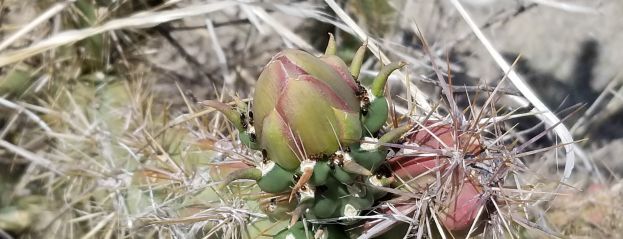
Building high-value homes in the grasslands
November 28, 2024
- •
- •
- •
Positioned near the centre of the Great Plains of North America, the Heartland Ranch Nature Preserve was an exceptional place to host the Great Plains Conservation Network (GPCN) Annual Meeting.
By Ruiping Luo
Read the PDF version here.
In late June, the Heartland Ranch Nature Preserve, managed by the Southern Plains Land Trust (SPLT) to protect over 40,000 acres of prairie, is a harsh landscape. Strong winds blow across the sunbaked ground, swirling dust and sand into the air. Cholla and prickly pear cacti stand beside brittle grasses, bushes fan their glossy green leaves into the sky, and a few resilient trees mark the now-dry river valley.
Even still, many species make their homes here. Between the rustling grasses, flowers blossom, adding splashes of pink and yellow and white. Insects swarm these blooms, feeding on the sweet nectar and, in turn, becoming food for the lizards scampering among the rocks and the birds plunging past. Elsewhere, a prairie dog stands guard, taking advantage of grasses grazed short by bison and cattle.
Positioned near the centre of the Great Plains of North America, the Heartland Ranch Nature Preserve was an exceptional place to host the Great Plains Conservation Network (GPCN) Annual Meeting.
GPCN is a collaboration of non-profit and tribal organizations and individuals working together to protect and restore North America’s grasslands. With representatives from Canada, United States, and Mexico, the grasslands network helps to coordinate conservation efforts and share information across the Great Plains. The group focuses on large landscape conservation to achieve its mission of maintaining natural processes in the grasslands. Many focal species, including bison and prairie dogs, need large spaces to survive.
The network acts to connect those working on the ground and by providing support. Over the past year, GPCN and its partner organizations have been busy assembling and improving Homes on the Range, a mapping project that works to identify and predict high-value habitats for black-tailed prairie dogs. Work is ongoing to expand this tool to include Canada and Mexico — the tool is currently concentrated on the United States — and to develop a similar tool for ideal bison habitat, to support bison reintroduction efforts. Accompanying the tool, a Black-footed Ferret Reintroduction Site Rapid Assessment Tool has been developed that helps determine the feasibility of ferret reintroduction to a site. These tools are meant to expedite and promote the reintroduction and management of focal species.
The Great Plains of North America are on the brink of collapse, with over 60 percent already lost, and more lands degraded and fragmented. Grassland bird populations have declined by more than half, and many of the plants and animals reliant on the grassland ecosystem are disappearing. Stopping the decline is more important than ever, and for that to happen, we need to work together, across the entire ecosystem, and we need networks like GPCN to connect conservation efforts across borders.
Amidst the parched ground and hard grasses, there is a ribbon of blue — water, collected by a beaver’s dam, feeding the lush plants nearby. Here, frogs swim and birds sing, gathering at the promise of moisture in an otherwise dry land. Not long ago, there were more of these havens, aided by beaver dams, wetlands and bison wallows that stored water on the semi-arid prairies. Many of these have been lost, but with enough work and patience, they can be restored. These lands, and the ongoing reintroduction and conservation work, are proof of that.
